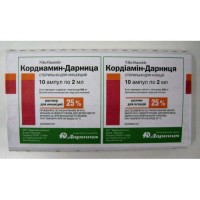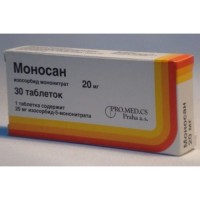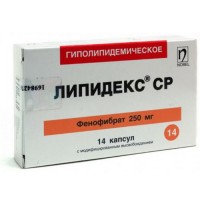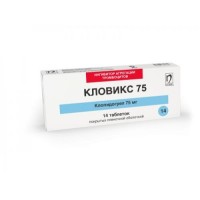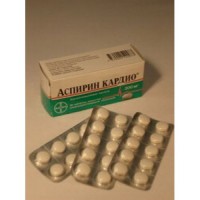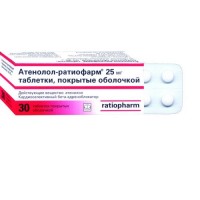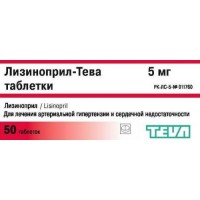Indap 2.5 mg (30 capsules)
- $10.20
The instruction for medical use
of Indap® medicine
the Trade name
of Indap®
the International
name Indapamid Lekarstvennaya a form
of the Capsule of 2.5 mg
Structure
One capsule contains
active agent - 2.5 mg of an indapamid
excipients: the granulated microcrystalline cellulose, lactose monohydrate, starch corn, magnesium stearate, silicon dioxide colloidal, indigo carmine, the titan dioxide, gelatin.
The description
Solid gelatin capsules size No. 4 with a lid blue and the body of white color. Contents of capsules – white or almost white powder.
Pharmacotherapeutic group
Diuretics. Not thiazide diuretics operating on a cortical segment of a Henle's loop. Sulfonamides. Indapamid
the ATX C03BA11 Code
the Pharmacological
Indapamid Pharmacokinetics properties at oral administration is quickly and completely soaked up. Peak concentration in blood are reached in 1-2 hours. Indapamid concentrates in erythrocytes and communicates proteins of plasma and erythrocytes up to 79%. Thanks to high solubility in fats concentrates in unstriated muscles of walls of vessels. Has dose-dependent effect. 70% of a single oral dose are removed through kidneys and 23% by means of digestive tract. Indapamid is allocated mainly in the form of inactive metabolites, 7% in not changed look. Elimination half-life (beta phase) of an indapamid makes about 15-18 hours. After reception of a single dose the maximum hypotensive effect is noted in 24 h. After multiple dose the therapeutic effect is noted in 1–2 weeks, reaches a maximum to 8–12 weeks.
The pharmacodynamics
Indapamid is derivative sulfonamide with an indolovy ring, pharmacological it is similar to tiazidovy diuretic means which influence by means of sodium reabsorption inhibition in a cortical segment of a distal tubule of nephron. Indapamid raises discharge of sodium and chlorides urine, and in a smaller measure and discharge of potassium and magnesium at the expense of what the volume of formation of urine increases, has antihypertensive effect. Researches showed that the daily dose of 2.5 mg causes the maximum antihypertensive effect, and the diuretic effect clinically is not shown. At this antihypertensive dose of 2.5 mg indapamid reduces vascular hyperreactivity to noradrenaline at patients with an arterial hypertension and reduces the general peripheric resistance and resistance of arterioles. Maintaining antihypertensive efficiency at patients with an anefrichesky hypertension podtverzhat the extrarenal mechanism of antihypertensive effect. Influence of an indapamid on blood vessels, includes:
- the decrease in a tone of smooth muscles of walls of vessels connected with transmembrane exchange of ions, first of all calcium
- the vazodilatation caused by stimulation of synthesis of PGE2 prostaglandin and PGI2 prostacyclin which is a vazodilatator and inhibitor of aggregation of platelets
- a potentsiation of vazodilatatorny influence of bradykinin.
At patients with hypertensia by means of short-term, medium-term and long-term observations it was revealed that indapamid:
- reduces a hypertrophy of a left ventricle of heart due to reduction of the sizes of cardiomyocytes
- does not influence metabolism of lipids: triglycerides, LDL - holesterin and HDL– of holesterin
- do not influence carbohydrate metabolism, including at patients
with hypertensia and diabetes.
Normalization of arterial blood pressure with considerable decrease in a microalbuminuria was observed after prolonged use of an indapamid at diabetics with a hypertension. Simultaneous use of an indapamid with other antihypertensive drugs (beta-blockers, blockers of calcium channels, APF inhibitors) leads to improvement of control of arterial hypertension with increase in frequency of reaction in comparison with monotherapy indapamidy.
Indications - essential hypertensia at adults
Indap ® accept the Route of administration and doses inside irrespective of meal, preferably in the morning till a breakfast, without chewing and washing down with enough water. Indap is applied as in mono - and in combination therapy.
The maximum daily dose - 2.5 mg. It is not recommended to exceed a daily dose higher than 2.5 mg. Higher doses do not increase antihypertensive effect of an indapamid, however increase its diuretic effect. In a combination with indapamidy beta-blockers, APF inhibitors, Methyldopum, a clonidine and other adrenoblockers can be used. Use of an indapamid in combination with diuretics is not recommended as it can lead to a hypopotassemia.
Side effects
Often (≥ 1% to & lt, 10%)
- makulopapulezny rash
Infrequently (≥ 0.1% to & lt, 1%)
- vomiting
- a purpura
Seldom (≥ 0.01% to & lt, 0.1%)
- increase in danger of dehydration of an organism at elderly and sick with cardiovascular insufficiency
- dizziness, fatigue, a headache, paresthesias
- allergic reactions, skin rash
- nausea, constipations, dryness in a mouth.
Very seldom (& lt, 1/10000)
- thrombocytopenia, a leukopenia, an agranulocytosis, aplastic anemia, hemolytic anemia
- arrhythmia, hypotonia
- pancreatitis
- a renal failure
-
- a Quincke's disease, and/or a small tortoiseshell, a toxic epidermal necrolysis, Stephens-Johnson's syndrome, a malignant exudative erythema
- a hypercalcemia, a hypopotassemia
Does not know an abnormal liver function
- in a liver failure, a possibility of appearance of hepatic encephalopathy
- possible deterioration in already existing sharp disseminate lupus erythematosus, a photosensitization
- reduction of content of potassium with development of a hypopotassemia that was shown in heavy degree in some groups of high risk
- a hyponatremia with a hypovolemia which lead to dehydration and orthostatic hypotension
- loss of ions of chlorine can cause a secondary metabolic alkalosis: frequency of emergence and intensity of this effect low.
- increase in level of uric acid in plasma and sugar level in blood during treatment: the expediency of use of drug has to be carefully weighed at patients with gout or diabetes.
Contraindications
- hypersensitivity to sulfonamides or to any excipient of drug
- hepatic encephalopathy and heavy abnormal liver functions
- a severe form of insufficiency of function of kidneys
- a hypopotassemia
- pregnancy and the period of a lactation
- children's age up to 18 years
- hereditary intolerance of fructose, deficiency of Lapp-lactose, glucose galactose malabsorption.
Medicinal interactions
Simultaneous use is not recommended:
Lithium drugs.
Increase in plasmatic level of lithium with signs of overdose, for example at a saltless diet (the lowered lithium discharge urine). If uses of diuretic means is necessary, then it is necessary to control systematically lithium level in plasma and to carry out the corresponding adjustment dosed
Antiarrhytmic drugs of the class Ia (quinidine, dihydroquinidine, Disopyramidum), antiarrhytmic drugs of class III (Amiodaronum, sotalol, dofetilid, ibutilid).
Antipsychotic drugs: fenotiazina (Chlorpromazinum, tsiamemazin, levomepromazinum, thioridazine, trifluoperazin), benzamides (amisulprid, Sulpiridum, sultoprid, tiaprid), phenyl propyl ketones (Droperidolum, haloperidol).
Other drugs: bepridit, tsizaprid, difemanit, erythromycin IV, galofantrin, mizolastin, pentamidine, sparfloksatsin, moxifloxacin, Vincaminum IV can cause torsades de pointes. The increased risk of developing of ventricular arrhythmias, especially torsades de pointes (the hypopotassemia is risk factor). Before using this combination of drugs it is necessary to carry out analyses for the purpose of identification of a hypopotassemia, at its existence, it is necessary to take necessary measures correction of a state. It is necessary to control a clinical state, plasmatic electrolytes and the ECG. It is necessary to use substances which do not cause torsades de pointes at a hypopotassemia: non-steroidal anti-inflammatory drugs (system), including TsOG-2 selection inhibitors, high doses of salicylic acid (≥ 3 g/days) as reduction of antihypertensive effect of an indapamid is possible. Risk of an acute renal failure at patients with dehydration (decrease in glomerular filtration). It is necessary to provide observation of function of kidneys of the patient, against the background of a large amount of the drunk water. Risk of acute hypotension and/or an acute renal failure, in case of an initiation of treatment angiotensin-converting enzyme inhibitor along with deficiency of sodium (especially at persons with a renal artery stenosis). In an arterial hypertension when the previous treatment by diuretics could result in deficiency of sodium, it is necessary or to stop use of diuretic within 3 days prior to treatment by APF inhibitors and, if necessary, to start over again applying the diuretics causing a hypopotassemia or to apply initially low doses of APF inhibitor and to gradually increase doses. In stagnant heart failure it is necessary, to begin treatment with very low dose of the APF inhibitor, or at a dose decline of at the same time applied diuretic causing a hypopotassemia. Anyway within the first weeks of treatment by APF inhibitors it is necessary to make careful observation of function of kidneys (on creatinine indicators in plasma). The increased risk of emergence of a hypopotassemia (the effect is summarized) arises at mutual use with Amphotericinum B (in / c), glucocorticoids and mineralokortikoida (system), tetrakosaktidy, stimulating (irritating) with laxatives. Constant control behind potassium level in blood plasma and, if necessary, the corresponding treatment is necessary, especially at simultaneous treatment by digoxin. When choosing depletive, it is necessary to apply the laxatives which are not stimulating motility of intestines. Baclofenum increases antihypertensive effect. In an initiation of treatment it is necessary to control function of kidneys against the background of a large amount of the drunk water. The hypopotassemia can increase risk of toxic influence of cardiac glycosides. In these cases it is necessary to control systematically potassium level in plasma, to register the ECG, and if necessary - to change treatment. Rational combinations with kaliysberegayushchy diuretics (amiloride, Spironolactonum, Triamterenum) very useful to some patients, do not exclude possibility of a hypopotassemia, and at patients with dysfunction of kidneys or with diabetes - hyperpotassemias. In these cases it is necessary to control potassium level in plasma, in need of EKG if it is required – to change treatment. Lactic acidosis after metformin use, is connected with possible insufficiency of function of kidneys because of reception of diuretic means, more 'loopback'. It is not necessary to use metformin if plasmatic levels of creatinine exceed 15 mg/l (135 mikromol/l) at men and 12 mg/l (110 mikromol/l) is at women. In dehydration of an organism, caused by diuretics, there is an increased risk of acute dysfunction of kidneys, especially in case of use of high doses of iodinated contrast means in a combination with indapamidy and increase risk of acute insufficiency of kidneys. In need of use of the last by the patient it is necessary to restore liquid loss. With imipraminovy antidepressants, neuroleptics there can be an increase in antihypertensive effect and risk of orthostatic hypotension (additive action). At co-administration from proyeparata of calcium (salt) the risk of a hypercalcemia as a result of decrease in discharge of calcium with urine increases. At co-administration with cyclosporine, takrolimusy the risk of increase in level of creatinine in plasma without change of level of the circulating cyclosporine, even without reduction of a ratio water / sodium increases. At co-administration with corticosteroids, tetrakosaktidy (system) decrease in antihypertensive effect is possible (reduction of a ratio water/sodium).
In a combination with indapamidy beta-blockers, APF inhibitors, Methyldopum, a clonidine and other adrenoblockers can be used. Use of an indapamid in combination with diuretic means is not recommended as it can lead to a hypopotassemia.
Special instructions
It is necessary to use with care drug in a liver failure. In an abnormal liver function thiazide diuretics can be the cause of development of hepatic encephalopathy. In this case, use of diuretics has to be immediately stopped. Photosensitization cases at use of such diuretics were registered as tiazida and their analogs. If during treatment the photosensitization is shown, it is recommended to stop treatment immediately. If reuse of diuretics is necessary, it is recommended to protect sensitive places from hit of solar or ultraviolet rays.
Water and electrolytic balance
- sodium Level in plasma: concentration of sodium in plasma needs to be defined before an initiation of treatment, and then through regular intervals to control its changes. Treatment with use of diuretics can be followed by a hyponatremia, sometimes with very serious consequences, at the same time in an initial stage the decrease in concentration of sodium in blood can have symptomless character. Therefore it is regularly recommended to control the plasmatic level of sodium, especially at the patients of advanced age and persons having cirrhosis.
- Potassium level in plasma: long use tiazidovy and it similar diuretics is connected with risk of reduction of potassium concentration in plasma and development of a hypopotassemia. Emergence of a hypopotassemia (& lt, 3.4 mmol/l) needs to be prevented at patients with the increased risk of its emergence, i.e. at elderly people, patients having exhaustion and also the patients taking along with diuretic drug other medicine, the patients having cirrhotic ascites with hypostases and also patients with diseases of coronary vessels and heart failure as the hypopotassemia in these cases increases toxic impact of drugs of a digitalis on heart and are raised by risk of developing of arrhythmia. The increased risk of emergence of a hypopotassemia is characteristic also of patients with the interval increased by QT, regardless of genesis of this phenomenon which can be inborn or caused by liver dysfunction. A hypopotassemia, also as well as a barikardiya, in this case cause predisposition to developing of heavy arrhythmias including deadly ventricular tachycardia (torsades de pointes). In all specified cases it is necessary to control more often potassium concentration level in plasma. Examination for the purpose of identification of a possible hypopotassemia needs to be performed in the first week of treatment. In case of identification of signs of a hypopotassemia it is necessary to take the appropriate measures directed to its prevention.
Calcium level in plasma: tiazidovy and to them similar diuretics can lower calcium discharge urine that can lead to small and temporary increase in concentration of calcium in plasma. The real hypercalcemia can be result of earlier not revealed hyperparathyreosis. In this case treatment it is necessary to stop and perform examination of function of parathyroids.
Glucose level in blood: at the patients having diabetes, especially in the presence of a hypopotassemia it is regularly necessary to control glucose level in blood.
Level of uric acid: at patients from the uric acid raised by concentration gout attacks
Function of a liver and diuretics are possible: tiazidovy and to them similar diuretics are most effective only at normal or minimum reduced function of kidneys (creatinine level in plasma less than 25 mg/l, that is adults have 220 µmol/l). At elderly patients, creatinine level in plasma should be estimated depending on age, weight and a floor. The hypovolemia caused by loss of water and sodium at treatment by diuretics lowers glomerular filtration that sometimes is followed by increase in level of urea and creatinine in plasma. At patients with normal function of kidneys such temporary functional renal failure, as a rule, does not lead to serious consequences, however, its emergence substantially can aggravate already existing renal failure.
Doping tests: indapamid can cause positivity at doping tests. Drug contains lactose as excipient. Patients with a rare hereditary disease of intolerance of a galactose, a lack of Lappa lactase or disturbance of absorption of glucose and a galactose, should not take this drug.
Use in pediatrics
Considering insufficiency of data on safety and efficiency of drug in pediatric practice it is recommended to refrain from its appointment at children's age up to 18 years.
Pregnancy and the period of a lactation
during pregnancy usually diuretic means are not appointed. Drug cannot be used for treatment of physiological hypostases at pregnancy at all. Diuretic means can become the cause of fetoplacental ischemia which creates threat for growth of a fruit. Indapamid gets into maternal milk therefore during administration of drug it is necessary to stop feeding by a breast.
The Drug Indap® does not lead feature of influence of drug on ability of control of vehicles and potentially dangerous mechanisms to disturbance of psychomotor reactions. However in some cases, especially in an initiation of treatment or at combination with other antigipertenzionny means, because of pressure decrease of blood the attention level can decrease that can will negatively affect ability to driving of vehicles and control of mechanisms.
Overdose
It was revealed what indapamid has no toxic effect to the dose of 40 mg, that is by 16 times exceeding a therapeutic dose. Symptoms: symptoms of acute poisoning are shown as result of a hypovolemia (hyponatremias, hypopotassemias). Such clinical manifestations as nausea, vomiting, hypotension, spasms, dizziness, drowsiness, a condition of confusion and confusion, a polyuria or an oliguria and even an anury are possible (as a result of a hypovolemia).
Treatment: to initial actions in case of overdose treat fast removal of the accepted substance (substances) by means of gastric lavage, if necessary – supply of activated carbon with the subsequent restoring the balance of water and electrolytes in specialized public health institution.
A form of release and packing
On 10 capsules in blister strip packaging (blister) from a film of polyvinylchloride and aluminum foil.
On 3 planimetric packs together with the instruction for medical use in the state and Russian languages place in a pack from cardboard.
To Store storage conditions in the dry, protected from light place at a temperature of 15-25 °C
to Store out of children's reach!
Not to apply a period of storage of 5 years after an expiration date.
Prescription status
According to the prescription
missile defense Producer. Prague honey.CS and. lake,
Telchsk 1, 140 00 Prague 4
Czech Republic
Owner of the registration certificate
of the missile defense. Prague honey.CS and. the lake,
Telchsk 1, 140 00 Prague 4
Czech Republic
the Address of the organization accepting in the territory of the Republic of Kazakhstan claims from consumers on quality of goods
of PROM.MEDIC.KAZ. LLP
Almaty, Dostyk Ave. 132, office 9, ph. 8 (727) 260-89-36, fax 8 (727) 260-89-36
Email:
To develop sekretar@prommedic.kz
of Indap® medicine
the Trade name
of Indap®
the International
name Indapamid Lekarstvennaya a form
of the Capsule of 2.5 mg
Structure
One capsule contains
active agent - 2.5 mg of an indapamid
excipients: the granulated microcrystalline cellulose, lactose monohydrate, starch corn, magnesium stearate, silicon dioxide colloidal, indigo carmine, the titan dioxide, gelatin.
The description
Solid gelatin capsules size No. 4 with a lid blue and the body of white color. Contents of capsules – white or almost white powder.
Pharmacotherapeutic group
Diuretics. Not thiazide diuretics operating on a cortical segment of a Henle's loop. Sulfonamides. Indapamid
the ATX C03BA11 Code
the Pharmacological
Indapamid Pharmacokinetics properties at oral administration is quickly and completely soaked up. Peak concentration in blood are reached in 1-2 hours. Indapamid concentrates in erythrocytes and communicates proteins of plasma and erythrocytes up to 79%. Thanks to high solubility in fats concentrates in unstriated muscles of walls of vessels. Has dose-dependent effect. 70% of a single oral dose are removed through kidneys and 23% by means of digestive tract. Indapamid is allocated mainly in the form of inactive metabolites, 7% in not changed look. Elimination half-life (beta phase) of an indapamid makes about 15-18 hours. After reception of a single dose the maximum hypotensive effect is noted in 24 h. After multiple dose the therapeutic effect is noted in 1–2 weeks, reaches a maximum to 8–12 weeks.
The pharmacodynamics
Indapamid is derivative sulfonamide with an indolovy ring, pharmacological it is similar to tiazidovy diuretic means which influence by means of sodium reabsorption inhibition in a cortical segment of a distal tubule of nephron. Indapamid raises discharge of sodium and chlorides urine, and in a smaller measure and discharge of potassium and magnesium at the expense of what the volume of formation of urine increases, has antihypertensive effect. Researches showed that the daily dose of 2.5 mg causes the maximum antihypertensive effect, and the diuretic effect clinically is not shown. At this antihypertensive dose of 2.5 mg indapamid reduces vascular hyperreactivity to noradrenaline at patients with an arterial hypertension and reduces the general peripheric resistance and resistance of arterioles. Maintaining antihypertensive efficiency at patients with an anefrichesky hypertension podtverzhat the extrarenal mechanism of antihypertensive effect. Influence of an indapamid on blood vessels, includes:
- the decrease in a tone of smooth muscles of walls of vessels connected with transmembrane exchange of ions, first of all calcium
- the vazodilatation caused by stimulation of synthesis of PGE2 prostaglandin and PGI2 prostacyclin which is a vazodilatator and inhibitor of aggregation of platelets
- a potentsiation of vazodilatatorny influence of bradykinin.
At patients with hypertensia by means of short-term, medium-term and long-term observations it was revealed that indapamid:
- reduces a hypertrophy of a left ventricle of heart due to reduction of the sizes of cardiomyocytes
- does not influence metabolism of lipids: triglycerides, LDL - holesterin and HDL– of holesterin
- do not influence carbohydrate metabolism, including at patients
with hypertensia and diabetes.
Normalization of arterial blood pressure with considerable decrease in a microalbuminuria was observed after prolonged use of an indapamid at diabetics with a hypertension. Simultaneous use of an indapamid with other antihypertensive drugs (beta-blockers, blockers of calcium channels, APF inhibitors) leads to improvement of control of arterial hypertension with increase in frequency of reaction in comparison with monotherapy indapamidy.
Indications - essential hypertensia at adults
Indap ® accept the Route of administration and doses inside irrespective of meal, preferably in the morning till a breakfast, without chewing and washing down with enough water. Indap is applied as in mono - and in combination therapy.
The maximum daily dose - 2.5 mg. It is not recommended to exceed a daily dose higher than 2.5 mg. Higher doses do not increase antihypertensive effect of an indapamid, however increase its diuretic effect. In a combination with indapamidy beta-blockers, APF inhibitors, Methyldopum, a clonidine and other adrenoblockers can be used. Use of an indapamid in combination with diuretics is not recommended as it can lead to a hypopotassemia.
Side effects
Often (≥ 1% to & lt, 10%)
- makulopapulezny rash
Infrequently (≥ 0.1% to & lt, 1%)
- vomiting
- a purpura
Seldom (≥ 0.01% to & lt, 0.1%)
- increase in danger of dehydration of an organism at elderly and sick with cardiovascular insufficiency
- dizziness, fatigue, a headache, paresthesias
- allergic reactions, skin rash
- nausea, constipations, dryness in a mouth.
Very seldom (& lt, 1/10000)
- thrombocytopenia, a leukopenia, an agranulocytosis, aplastic anemia, hemolytic anemia
- arrhythmia, hypotonia
- pancreatitis
- a renal failure
-
- a Quincke's disease, and/or a small tortoiseshell, a toxic epidermal necrolysis, Stephens-Johnson's syndrome, a malignant exudative erythema
- a hypercalcemia, a hypopotassemia
Does not know an abnormal liver function
- in a liver failure, a possibility of appearance of hepatic encephalopathy
- possible deterioration in already existing sharp disseminate lupus erythematosus, a photosensitization
- reduction of content of potassium with development of a hypopotassemia that was shown in heavy degree in some groups of high risk
- a hyponatremia with a hypovolemia which lead to dehydration and orthostatic hypotension
- loss of ions of chlorine can cause a secondary metabolic alkalosis: frequency of emergence and intensity of this effect low.
- increase in level of uric acid in plasma and sugar level in blood during treatment: the expediency of use of drug has to be carefully weighed at patients with gout or diabetes.
Contraindications
- hypersensitivity to sulfonamides or to any excipient of drug
- hepatic encephalopathy and heavy abnormal liver functions
- a severe form of insufficiency of function of kidneys
- a hypopotassemia
- pregnancy and the period of a lactation
- children's age up to 18 years
- hereditary intolerance of fructose, deficiency of Lapp-lactose, glucose galactose malabsorption.
Medicinal interactions
Simultaneous use is not recommended:
Lithium drugs.
Increase in plasmatic level of lithium with signs of overdose, for example at a saltless diet (the lowered lithium discharge urine). If uses of diuretic means is necessary, then it is necessary to control systematically lithium level in plasma and to carry out the corresponding adjustment dosed
Antiarrhytmic drugs of the class Ia (quinidine, dihydroquinidine, Disopyramidum), antiarrhytmic drugs of class III (Amiodaronum, sotalol, dofetilid, ibutilid).
Antipsychotic drugs: fenotiazina (Chlorpromazinum, tsiamemazin, levomepromazinum, thioridazine, trifluoperazin), benzamides (amisulprid, Sulpiridum, sultoprid, tiaprid), phenyl propyl ketones (Droperidolum, haloperidol).
Other drugs: bepridit, tsizaprid, difemanit, erythromycin IV, galofantrin, mizolastin, pentamidine, sparfloksatsin, moxifloxacin, Vincaminum IV can cause torsades de pointes. The increased risk of developing of ventricular arrhythmias, especially torsades de pointes (the hypopotassemia is risk factor). Before using this combination of drugs it is necessary to carry out analyses for the purpose of identification of a hypopotassemia, at its existence, it is necessary to take necessary measures correction of a state. It is necessary to control a clinical state, plasmatic electrolytes and the ECG. It is necessary to use substances which do not cause torsades de pointes at a hypopotassemia: non-steroidal anti-inflammatory drugs (system), including TsOG-2 selection inhibitors, high doses of salicylic acid (≥ 3 g/days) as reduction of antihypertensive effect of an indapamid is possible. Risk of an acute renal failure at patients with dehydration (decrease in glomerular filtration). It is necessary to provide observation of function of kidneys of the patient, against the background of a large amount of the drunk water. Risk of acute hypotension and/or an acute renal failure, in case of an initiation of treatment angiotensin-converting enzyme inhibitor along with deficiency of sodium (especially at persons with a renal artery stenosis). In an arterial hypertension when the previous treatment by diuretics could result in deficiency of sodium, it is necessary or to stop use of diuretic within 3 days prior to treatment by APF inhibitors and, if necessary, to start over again applying the diuretics causing a hypopotassemia or to apply initially low doses of APF inhibitor and to gradually increase doses. In stagnant heart failure it is necessary, to begin treatment with very low dose of the APF inhibitor, or at a dose decline of at the same time applied diuretic causing a hypopotassemia. Anyway within the first weeks of treatment by APF inhibitors it is necessary to make careful observation of function of kidneys (on creatinine indicators in plasma). The increased risk of emergence of a hypopotassemia (the effect is summarized) arises at mutual use with Amphotericinum B (in / c), glucocorticoids and mineralokortikoida (system), tetrakosaktidy, stimulating (irritating) with laxatives. Constant control behind potassium level in blood plasma and, if necessary, the corresponding treatment is necessary, especially at simultaneous treatment by digoxin. When choosing depletive, it is necessary to apply the laxatives which are not stimulating motility of intestines. Baclofenum increases antihypertensive effect. In an initiation of treatment it is necessary to control function of kidneys against the background of a large amount of the drunk water. The hypopotassemia can increase risk of toxic influence of cardiac glycosides. In these cases it is necessary to control systematically potassium level in plasma, to register the ECG, and if necessary - to change treatment. Rational combinations with kaliysberegayushchy diuretics (amiloride, Spironolactonum, Triamterenum) very useful to some patients, do not exclude possibility of a hypopotassemia, and at patients with dysfunction of kidneys or with diabetes - hyperpotassemias. In these cases it is necessary to control potassium level in plasma, in need of EKG if it is required – to change treatment. Lactic acidosis after metformin use, is connected with possible insufficiency of function of kidneys because of reception of diuretic means, more 'loopback'. It is not necessary to use metformin if plasmatic levels of creatinine exceed 15 mg/l (135 mikromol/l) at men and 12 mg/l (110 mikromol/l) is at women. In dehydration of an organism, caused by diuretics, there is an increased risk of acute dysfunction of kidneys, especially in case of use of high doses of iodinated contrast means in a combination with indapamidy and increase risk of acute insufficiency of kidneys. In need of use of the last by the patient it is necessary to restore liquid loss. With imipraminovy antidepressants, neuroleptics there can be an increase in antihypertensive effect and risk of orthostatic hypotension (additive action). At co-administration from proyeparata of calcium (salt) the risk of a hypercalcemia as a result of decrease in discharge of calcium with urine increases. At co-administration with cyclosporine, takrolimusy the risk of increase in level of creatinine in plasma without change of level of the circulating cyclosporine, even without reduction of a ratio water / sodium increases. At co-administration with corticosteroids, tetrakosaktidy (system) decrease in antihypertensive effect is possible (reduction of a ratio water/sodium).
In a combination with indapamidy beta-blockers, APF inhibitors, Methyldopum, a clonidine and other adrenoblockers can be used. Use of an indapamid in combination with diuretic means is not recommended as it can lead to a hypopotassemia.
Special instructions
It is necessary to use with care drug in a liver failure. In an abnormal liver function thiazide diuretics can be the cause of development of hepatic encephalopathy. In this case, use of diuretics has to be immediately stopped. Photosensitization cases at use of such diuretics were registered as tiazida and their analogs. If during treatment the photosensitization is shown, it is recommended to stop treatment immediately. If reuse of diuretics is necessary, it is recommended to protect sensitive places from hit of solar or ultraviolet rays.
Water and electrolytic balance
- sodium Level in plasma: concentration of sodium in plasma needs to be defined before an initiation of treatment, and then through regular intervals to control its changes. Treatment with use of diuretics can be followed by a hyponatremia, sometimes with very serious consequences, at the same time in an initial stage the decrease in concentration of sodium in blood can have symptomless character. Therefore it is regularly recommended to control the plasmatic level of sodium, especially at the patients of advanced age and persons having cirrhosis.
- Potassium level in plasma: long use tiazidovy and it similar diuretics is connected with risk of reduction of potassium concentration in plasma and development of a hypopotassemia. Emergence of a hypopotassemia (& lt, 3.4 mmol/l) needs to be prevented at patients with the increased risk of its emergence, i.e. at elderly people, patients having exhaustion and also the patients taking along with diuretic drug other medicine, the patients having cirrhotic ascites with hypostases and also patients with diseases of coronary vessels and heart failure as the hypopotassemia in these cases increases toxic impact of drugs of a digitalis on heart and are raised by risk of developing of arrhythmia. The increased risk of emergence of a hypopotassemia is characteristic also of patients with the interval increased by QT, regardless of genesis of this phenomenon which can be inborn or caused by liver dysfunction. A hypopotassemia, also as well as a barikardiya, in this case cause predisposition to developing of heavy arrhythmias including deadly ventricular tachycardia (torsades de pointes). In all specified cases it is necessary to control more often potassium concentration level in plasma. Examination for the purpose of identification of a possible hypopotassemia needs to be performed in the first week of treatment. In case of identification of signs of a hypopotassemia it is necessary to take the appropriate measures directed to its prevention.
Calcium level in plasma: tiazidovy and to them similar diuretics can lower calcium discharge urine that can lead to small and temporary increase in concentration of calcium in plasma. The real hypercalcemia can be result of earlier not revealed hyperparathyreosis. In this case treatment it is necessary to stop and perform examination of function of parathyroids.
Glucose level in blood: at the patients having diabetes, especially in the presence of a hypopotassemia it is regularly necessary to control glucose level in blood.
Level of uric acid: at patients from the uric acid raised by concentration gout attacks
Function of a liver and diuretics are possible: tiazidovy and to them similar diuretics are most effective only at normal or minimum reduced function of kidneys (creatinine level in plasma less than 25 mg/l, that is adults have 220 µmol/l). At elderly patients, creatinine level in plasma should be estimated depending on age, weight and a floor. The hypovolemia caused by loss of water and sodium at treatment by diuretics lowers glomerular filtration that sometimes is followed by increase in level of urea and creatinine in plasma. At patients with normal function of kidneys such temporary functional renal failure, as a rule, does not lead to serious consequences, however, its emergence substantially can aggravate already existing renal failure.
Doping tests: indapamid can cause positivity at doping tests. Drug contains lactose as excipient. Patients with a rare hereditary disease of intolerance of a galactose, a lack of Lappa lactase or disturbance of absorption of glucose and a galactose, should not take this drug.
Use in pediatrics
Considering insufficiency of data on safety and efficiency of drug in pediatric practice it is recommended to refrain from its appointment at children's age up to 18 years.
Pregnancy and the period of a lactation
during pregnancy usually diuretic means are not appointed. Drug cannot be used for treatment of physiological hypostases at pregnancy at all. Diuretic means can become the cause of fetoplacental ischemia which creates threat for growth of a fruit. Indapamid gets into maternal milk therefore during administration of drug it is necessary to stop feeding by a breast.
The Drug Indap® does not lead feature of influence of drug on ability of control of vehicles and potentially dangerous mechanisms to disturbance of psychomotor reactions. However in some cases, especially in an initiation of treatment or at combination with other antigipertenzionny means, because of pressure decrease of blood the attention level can decrease that can will negatively affect ability to driving of vehicles and control of mechanisms.
Overdose
It was revealed what indapamid has no toxic effect to the dose of 40 mg, that is by 16 times exceeding a therapeutic dose. Symptoms: symptoms of acute poisoning are shown as result of a hypovolemia (hyponatremias, hypopotassemias). Such clinical manifestations as nausea, vomiting, hypotension, spasms, dizziness, drowsiness, a condition of confusion and confusion, a polyuria or an oliguria and even an anury are possible (as a result of a hypovolemia).
Treatment: to initial actions in case of overdose treat fast removal of the accepted substance (substances) by means of gastric lavage, if necessary – supply of activated carbon with the subsequent restoring the balance of water and electrolytes in specialized public health institution.
A form of release and packing
On 10 capsules in blister strip packaging (blister) from a film of polyvinylchloride and aluminum foil.
On 3 planimetric packs together with the instruction for medical use in the state and Russian languages place in a pack from cardboard.
To Store storage conditions in the dry, protected from light place at a temperature of 15-25 °C
to Store out of children's reach!
Not to apply a period of storage of 5 years after an expiration date.
Prescription status
According to the prescription
missile defense Producer. Prague honey.CS and. lake,
Telchsk 1, 140 00 Prague 4
Czech Republic
Owner of the registration certificate
of the missile defense. Prague honey.CS and. the lake,
Telchsk 1, 140 00 Prague 4
Czech Republic
the Address of the organization accepting in the territory of the Republic of Kazakhstan claims from consumers on quality of goods
of PROM.MEDIC.KAZ. LLP
Almaty, Dostyk Ave. 132, office 9, ph. 8 (727) 260-89-36, fax 8 (727) 260-89-36
Email:
To develop sekretar@prommedic.kz

